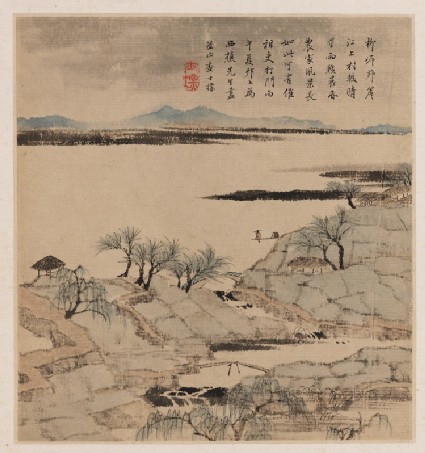Chinese Paintings in the Ashmolean Museum, Oxford
A catalogue of the Ashmolean collection of Chinese paintings by Shelagh Vainker (published Oxford, 2000).

Publications online: 222 objects
- Reference URL
Actions
River landscape
-
Literature notes
Zha Shibiao was from Haiyang near Xiuying in Anhui province and is associated with the Anhui School, renowned for dry brushwork and sparse composition. Zha Shibiao studied for the civil service examinations before the fall of the Ming dynasty, and it has been suggested that his subsequent departure from official life in favour of painting may have been prompted by lack of sympathy for the new rule. His family owned collections of paintings and bronzes and he himself was a connoisseur. In painting he followed his near contemporary Hong Ren and the Yuan master Ni Zan. From the 1670s onwards he lived in Yangzhou. -
Description
Zha Shibiao, also known as Meihe or Erzhan, was from Xin’an in Anhui province. He is regarded as one of the four masters of the Xin’an School, and is renowned for his dry brushwork and sparse composition. The artist studied for the civil service examinations before the fall of the Ming dynasty, and it has been suggested that his subsequent departure from official life in favour of painting may have been prompted by lack of sympathy for the new rule.
From the 1670s onwards Zha Shibiao lived in Yangzhou. His family owned collections of paintings and bronzes, and he himself was a connoisseur. In painting he followed his contemporary Hong Ren (1610-1664) and master from the Yuan dynasty, Ni Zan (1301-1374).
On this painting, the artist inscribes: ‘Along the bank of willows there are gardens and houses in this village on the river; sometimes cloudless, sometimes a few raindrops, so do mornings and dawns pass by; [I wish] the landscape of the peasant family could be like this forever; are there any officers knocking at doors asking for taxes?’.
-
Details
- Associated place
-
Asia › China › Jiangsu province › Yangzhou (place of creation)
- Date
- May - August 1666
- Artist/maker
-
Zha Shibiao (1615 - 1698) (artist)
- Associated people
-
Wang Shilu (1626 - 1673) (recipient)
- Material and technique
- ink and colour on paper
- Dimensions
-
mount 55.6 x 45 cm (height x width)
page 26.9 x 22.5 cm (height x width)
painting 19 x 17.5 cm (height x width)
- Material index
- Technique index
- Object type index
- No. of items
- 1
- Credit line
- Purchased with the assistance of the MLA/V&A Purchase Grant Fund, theArt Fund, and Friends of the Ashmolean Museum, 1980.
- Accession no.
- EA1980.142
-
Further reading
Vainker, Shelagh, Chinese Paintings in the Ashmolean Museum, Oxford (Oxford: Ashmolean Museum, 2000), no. 159 on p. 184, illus. p. 185 fig. 159
Past Exhibition
see (1)Location
-
- currently in research collection
Objects are sometimes moved to a different location. Our object location data is usually updated on a monthly basis. Contact the Jameel Study Centre if you are planning to visit the museum to see a particular object on display, or would like to arrange an appointment to see an object in our reserve collections.
Publications online
-

Chinese Paintings in the Ashmolean Museum, Oxford
Zha Shibiao was from Haiyang near Xiuying in Anhui province and is associated with the Anhui School, renowned for dry brushwork and sparse composition. Zha Shibiao studied for the civil service examinations before the fall of the Ming dynasty, and it has been suggested that his subsequent departure from official life in favour of painting may have been prompted by lack of sympathy for the new rule. His family owned collections of paintings and bronzes and he himself was a connoisseur. In painting he followed his near contemporary Hong Ren and the Yuan master Ni Zan. From the 1670s onwards he lived in Yangzhou.
Notice
Object information may not accurately reflect the actual contents of the original publication, since our online objects contain current information held in our collections database. Click on 'buy this publication' to purchase printed versions of our online publications, where available, or contact the Jameel Study Centre to arrange access to books on our collections that are now out of print.
© 2013 University of Oxford - Ashmolean Museum


